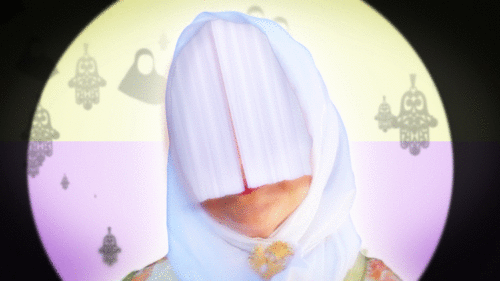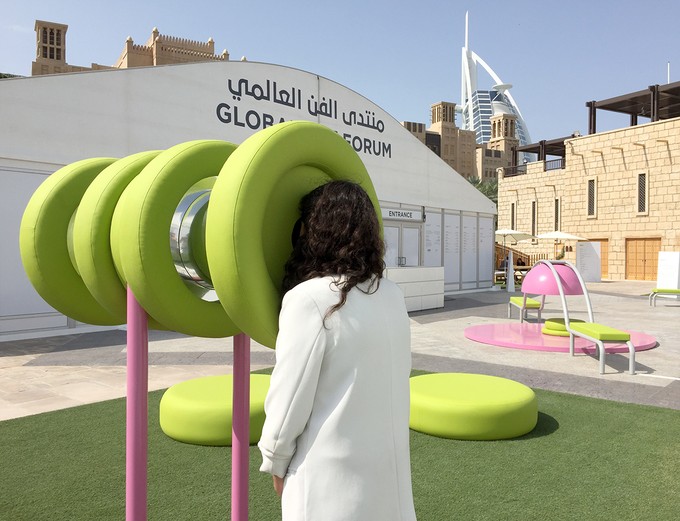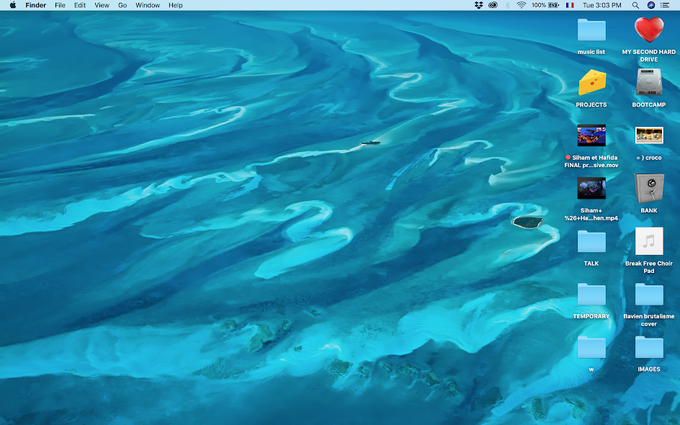The latest in a series of interviews with artists who have a significant body of work that makes use of or responds to network culture and digital technologies.
Meriem Bennani grew up in Rabat, Morocco, and Paris and has lived in New York for the past decade. Her multimedia practice engages identity as related to femininity, feminism, and the intersection of religious and secular pop culture in her native Morocco, New York, and globally. Bennani’s practice encompasses video works that appear in expansive and immersive spaces, from a farcical advertisement for festive holiday hijabs that screened on the giant oculus screen of Brooklyn’s Barclays Center (Your Year by Fardaous Funjab, 2017), to whimsical interactive viewing stations that presented playful portraits of Moroccan women at the Art Dubai fair in the United Arab Emirates (Ghariba/Stranger, 2017). She both celebrates and exposes the private lives of women—from her own family members, to those on the street, in popular media, and in her digitally tuned-in world. Straddling these oft-disparate cultural interstices, her clever, socially pertinent works resist simple categorization.

Fardaous Funjab (2015–2017)
Simone Krug: Your delightful video Fardaous Funjab (2015–2017) is a mock-reality show that follows the life of a fictional hijab designer who creates futuristic, campy, almost ludicrous designs using a tennis ball basket, a multi-tiered wedding cake, and so on. This piece troubles the way Muslim women are portrayed in the media, where the hijab becomes a fun, silly fashion accessory. Do you see works like this one as narratives? Of course, you apply the imaginative potential of the digital to animating and creating comical anecdotes. With this in mind, how do you engage with or consider the idea of storytelling?
Meriem Bennani: Most of my work is about stories and how to tell them best. I believe so much in the super stickiness of the emotional continuity that defines storytelling that I don’t ever treat it with care. I like to submerge it and hit kick lick it implode it in any way possible … in a very organized fashion, though!! I don’t care for a single way of telling the story throughout. I think that if each segment can be told in the language most adapted to it, why not?
So you know the love scene can be from a soap, the argument, reality t.v., and the party scene, wedding footage. The storyline pierces through, and it holds all the experiments together. It is like playing Jenga super dangerously, but really, you’re using superglue in between. At the end, the tower looks like never before. Hopefully in a good way ...
SK: Video pieces like Fardaous Funjab delve into the cultural import of the traditional Islamic women’s head covering and seem to both glorify and critique the image of the hijab in both Moroccan but also in global visual culture today. Could you expand on your interest in this subject and the themes it evokes for you?
MB: These works are mostly from 2015. You know, I age like a dog or a pop song, seven years at a time. I lost some interest in the subject in some ways. Although absurd and surreal, these works are descriptive. For a woman who wears the hijab every day, or in places where most women cover themselves, I don’t think that the veil is seen as a religious object every single time it is put on. On a daily basis, fashion also plays an important role. If you look at all the Modest Fashion bloggers, it’s very clear that the hijab has established on its own an existence in the fashion world. Fardaous Funjab can be about reality television, success, money, and fashion in general, not only in the Middle East. I want to depict and reimagine these ideas, without having to establish them in an occidental setting to reach universality.

Ghariba / Stranger (2017)
SK: More recent examples of your work think about womanhood differently and take on a more documentary style. You've exhibited the multichannel video and installation Sifam & Hafida (2017) at The Kitchen in New York City; in it, you explore a generational rivalry between two women who sing traditional Moroccan prose poetry known as aita. You’ve also presented the multichannel video and outdoor installation Ghariba/Stranger (2017) at Art Dubai in the United Arab Emirates, a piece which depicts a personalized perspective into the lives of four Moroccan women as they go about their day. Considering these more recent pieces, could you speak more about how your work has changed?
MB: I guess from Fardaous Funjab to these pieces, the biggest shift happens in my process in choosing the starting point for the piece. Fardaous came after mostly making drawings and animations, which means constantly making work that is some sort of invention of a fictional setting, or through a heavy filtering of reality. Fardaous was almost fully scripted. When I shot it, though, I realized my favorite scenes were when my mother (in the role of Fardaous) would improvise and word things in ways I could never have written alone because I’m not a screenwriter. I don’t have that (very impressive) skill which makes writers come up with voices outside of their bodies! In Ghariba and Siham & Hafida, I adopted a more collaborative approach and tried to use the moment of shooting like an opportunity to bring these outside voices into my work, which is more collaborative and scary for me. I moved the invention part to post-production, in the edit, where I recreate an artificial and amplified version of the narrative and characters through editing and digital manipulation.
SK: Shifting gears a bit, I want to ask about your interest in digital culture. You've made pieces in which you comically elongate iPhones or animate the Apple logo such that it's a shimmying, jiggling icon, as in your work iButt (2015). These slight tweaks are comical in that we still recognize the commonly used objects and universal logos you're playing with. On your Instagram last year you posted a hilarious, if not disquieting, animated clip of Donald Trump staring up at the August 2017 solar eclipse, wearing sunglasses with lenses that both resemble and then transform into hooded KKK figures in the sky. Could you elaborate on what draws you to manipulation and distortion as an approach to making? Further, what's appealing about using these mainstream images, commodities, and brands?
MB: Those short clips and Instagram videos are disposable ideas more than full pieces, much like the products or events they are referencing. It’s funny to reference things that are very time sensitive and then watch them sink into obsolescence at a high speed. When I watch the video from my show FLY from 2016 and hear Rihanna’s Kiss It Better in the soundtrack which featured in this piece, I feel nostalgic for that summer. It feels dated. I remember choosing that song as a time experiment because it was a hit then, and it would act as a chronological marker. Using popular songs and mainstream or iconic references is just a tool, the fastest shortcut to some type of universal signifier that will land a joke or idea in a heartbeat. I only find it useful or interesting when it’s made for a specific format that needs to be efficient immediately, almost like a cartoon or a meme. I care less about this when it comes to other longer term projects.
SK: Pivoting from this discussion of the internet, I want to ask about the way you’ve discussed your work in terms of its “frantic internet pace” in the past. This jerky, speedy momentum is notably present throughout your immersive multimedia work FLY which you just mentioned; FLY showed at PS1 in 2016, featuring a buzzing animated fruit fly flitting around diaristic footage of a day in the life Rabat, from the open stalls of an outdoor marketplace to a wide boulevard where locals congregate around a tiled fountain. Presented on multiple, sculpturally stacked monitors, this colorful, mesmeric piece emanated a convulsive, fast-paced cadence. What’s appealing to you about this pace? Do you ever think about slowing down?
MB: My work would only slow down if I did, which seems difficult these days. I’ve been thinking more and more about how production schedules and budgets end up shaping art and its frequencies. This is not the sexiest idea and most of us don’t want to admit it, but it’s true. I sometimes think about that fruit fly, a digital character I created for FLY, and how she would probably collapse if she stopped moving, almost as if her robotic body was powered kinetically. This way of rushing through the world and ideas shapes the speed of my edits. A lot of the movements are most likely inspired by the experience of browsing, so in a way my fast pace mimics the pace of the first steps of online research, and at the end the research itself becomes the exposé: it compiles content from different sources, all served in their original containers.

Siham & Hafida (2017)
SK: Let’s move on to discuss the physical environments you create for your videos, which are often projected onto multidimensional screens, as in Siham & Hafida, 2017. How do you think about the idea of using surfaces as mediums for conveying larger concepts? Does that idea hold any significance for you as you create?
MB: The word surface makes me think of projectors. Something feels very old school about projecting, a two-part apparatus (the projector and the screen) circulating the moving image. I wish I could get an image on a full wall or sculpture without projection mapping, but from within. Wouldn’t it be incredible to be able to turn any three-dimensional object into an LCD screen? It reminds me of the use of gold in Russian miniatures as a divine light being produced by the object, rather than depicted as an idea of itself. When the light comes to the surface from within, the object feels like it has a mysterious origin. Not to get too spiritual! With projectors, you trace back the light source and it’s ... a projector! And that machine becomes part of the work. Many artists who work with video and installation are trying to stretch the poetics and aesthetics of projectors and their hanging, and expose the devices inside the installations, but their position outside of the screens is always a reminder of the surface.
SK: What is the significance of creating immersive spaces with whimsically shaped screens and seating for your video pieces (as with Siham and Hafida, and many other pieces)? Is there something about the act of viewing that necessitates this type of space? Do you see yourself as an artist who works in installation? How do you see the body interacting with your works in space
MB: I see my installations as experiments around new viewing solutions. The single channel option was inherited by cinema from art and photo history, and it feels like our relationship with screens today should help update the way moving image is presented. We got so good at navigating multiple devices, yet the single channel prevails as a default. Initially, the immersive space is not necessary to the viewing but as I work on the videos and the 3D drawings of the installation simultaneously, and inside the same laptop screen, they develop a relationship. They make the jump from my harddrive to the world together, are shown for the first time as a pair, and become necessary to each other through that process. It’s kind of emotional. I started making installations and sculptures to host moving image. In this way, caring so much about the viewing of the video tricked me into becoming someone who works in installation and sculpture. I never thought I would think in those terms.
SK: Do you consider the way that distraction and attention function today in creating spaces like this?
MB: I think about it a lot! I always think: how do I make people want to be in this space for the full time of the video loop? And this challenge is getting harder as I move towards longer video formats with a storyline that requires one to watch the video in a linear way. First, I always make sure it’s comfortable, kinda like the installation where you can take a nap and end up watching the whole thing. Here again, the storyline is great glue: for your body to stay, I mean! There is a constant push and pull between the story or characters allowing you to engage, and the sculptures or special effects pushing you out. But in this way, the distraction remains within the piece. You are in and out of the core of the story but still inside the space of the video and its installation. And even if you take a phone break, you are inside the video, another character negotiating your life on and offline, along with the ones on camera.
SK: Can you talk about new themes you're working on now?
MB: I am working on a science fiction project that has to do with immigration in a teleportation era, with a focus on the African diaspora.
Questionnaire
Age: 30
Location: Brooklyn
How/when did you begin working creatively with technology? When I was a teenager. I used Photoshop and made music on the demo version of this software I got in a cereal box.
Where did you go to school? What did you study? I went to Ecole Nationale Supérieure des Arts Décoratifs in Paris for animation and then Cooper Union here in NYC.
What do you do for a living or what occupations have you held previously? I do a lot of animation and after effects for production companies.
What does your desktop or workspace look like? (Pics or screenshots please!)
It’s very simple :

